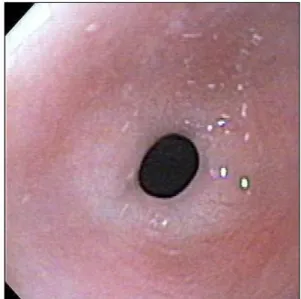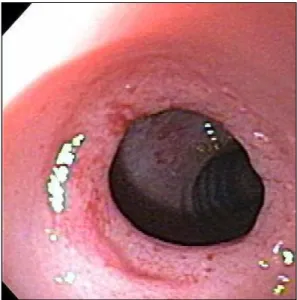pISSN: 2234-8646 eISSN: 2234-8840 https://doi.org/10.5223/pghn.2018.21.4.351
Pediatr Gastroenterol Hepatol Nutr 2018 October 21(4):351-354
PGHN
Case Report
PEDIATRIC GASTROENTEROLOGY, HEPATOLOGY & NUTRITION
Endoscopic Balloon Dilation for Treatment of Congenital Antral Web
Jacquelin Peck, Racha Khalaf*, Ryan Marth
†, Claudia Phen
‡, Roberto Sosa
§, Francisco Balsells Cordero
∥, and Michael Wilsey
¶Pediatric Anesthesiology, *Pediatric Gastroenterology, Hepatology and Nutrition, Children’s Hospital of Colorado, Denver, CO, †College of Arts and Science, University of South Florida St. Petersburg, St. Petersburg, FL, ‡Office of Medical Education, §International Medicine, and ¶Pediatric Gastroenterology, Johns Hopkins All Children’s Hospital, St. Petersburg, FL, United States, ∥Gastroenterología Pediátrica, Hospital Herrera Llerandi, Guatemala City, Guatemala
Congenital antral webs are a rare but relevant cause of gastric outlet obstruction in infants and children. The condition may lead to feeding refusal, vomiting, and poor growth. Due to the relative rarity of the disease, cases of congenital antral web are frequently misdiagnosed or diagnosed with significant delay as physicians favorably pursue diagnoses of pyloric stenosis and gastric ulcer disease, which are more prevalent. We report a case of an eight-month-old female who presented with persistent non-bilious emesis, feeding difficulties, and failure to thrive and was discovered to have an antral web. The web was successfully treated with endoscopic balloon dilation, which resolved her symptoms. Two years later, the patient remains asymptomatic and is thriving with weight at the 75th percentile for her age.
Key Words: Gastric outlet obstruction, Pediatrics, Vomiting, Failure to thrive, Endoscopy
Received:December 1, 2017, Revised:January 12, 2018, Accepted:February 14, 2018
Corresponding author: Michael Wilsey, Pediatric Gastroenterology, Johns Hopkins All Children’s Hospital, 601 Fifth Street South, Suite 605, St.
Petersburg, FL 33701, United States. Tel: +1-727-822-4300, Fax: +1-727-456-1399, E-mail: mwilsey1@jhmi.edu Copyright ⓒ 2018 by The Korean Society of Pediatric Gastroenterology, Hepatology and Nutrition
This is an openaccess article distributed under the terms of the Creative Commons Attribution NonCommercial License (http://creativecommons.org/licenses/by-nc/4.0/) which permits unrestricted noncommercial use, distribution, and reproduction in any medium, provided the original work is properly cited.
INTRODUCTION
A congenital antral web is a thin mucous mem- brane that can be found one to two centimeters prox- imal to the pylorus and can lead to narrowing of the antrum leading to gastric outlet obstruction [1]. It is an uncommon finding with an incidence of 1 in 100,000 births [2]. The exact etiology is unknown, but involves incomplete recanalization of embryonic
development during early gestation [2].
Clinical presentation in neonates includes feeding difficulties and recurrent, non-bilious vomiting, while pediatric presentation is more consistent with nausea, early satiety, and epigastric pain [3]. Because of the vague nature of these symptoms, physicians may miss or delay the diagnosis of antral web due to higher suspicion of pyloric stenosis or peptic ulcer disease, which are more prevalent [4]. Reported
352 Vol. 21, No. 4, October 2018 Pediatr Gastroenterol Hepatol Nutr
Fig. 1. Pre-ablation antral web viewed endoscopically. Gray tissue comprised of hypertrophied mucosa narrowing the lumen of the pylorus. Opening measuring 5 to 6 mm in diameter.
Fig. 2. Endoscopic view of antral web ablation. Mucosal tearing is evident by gaps within the gray mucosal tissue revealing dark muscular tissue of the pylorus underneath as viewed endoscopically through the balloon. Serial balloon dilatation using controlled radial expansion balloons (CRE;
Boston Scientific, Marlborough, MA, USA) were inserted in the pylorus and gradually expanded first to 9 then to 10 mm, and then to 11 and 12 mm, then a third balloon was used to dilate to 13.5 mm and then finally 15 mm, ranging between 1 to 2 minutes at each session (2 minutes for the final two).
complications of congenital antral webs include fail- ure to thrive, and rarely, gastric perforation [5].
CASE REPORT
We present the case of an eight-month-old Hispanic female with feeding refusal, vomiting, and poor growth. Upon presentation, her weight was at the 12th percentile and length was at the 11th percentile for age. Upper gastrointestinal contrast series re- vealed a congenital antral web. She was evaluated by the pediatric surgeon in Guatemala; however, the family preferred a less invasive approach. Therefore, she was referred to our institution for therapeutic endoscopy.
Upper gastrointestinal endoscopy at our in- stitution revealed a small membranous web in the antrum of the stomach, extending inward from the pylorus. Upon initial endoscopy, an Olympus GIF 160 (Olympus Co., Tokyo, Japan) endoscope with an external diameter of 8.6 mm was inserted atraumati- cally through a bite block and advanced through the esophagus and into the gastric antrum. Here, a con- genital antral web measuring approximately 5 to 6
mm in diameter was identified (Fig. 1). Using a gen- tle torqueing maneuver, the scope was advanced be- yond the web to reveal normal mucosa distally.
Withdrawing the scope revealed a significant degree of antral web ablation secondary to the initial scope advancement. Controlled radial expansion balloons (CRE; Boston Scientific, Marlborough, MA, USA) were then used to sequentially dilate the antral web.
The balloons were advanced in to the pylorus and gradually expanded first to 9 and 10 mm, then to 11 and 12 mm, then finally to 13.5 and 15 mm for 1 to 2 minutes per session. Upon reaching a diameter of 12 mm, the balloon met resistance and endoscopic visu- alization through the balloon showed disruption of the mucosa to reveal muscular fibers of the normal pylorus below (Fig. 2). The endoscope was then slowly withdrawn, revealing ablation of the web with no unintended injury (Fig. 3). The patient tol- erated the procedure well, and after a period of ob- servation, she was discharged with no significant
www.pghn.org 353
Jacquelin Peck, et al:Endoscopic Balloon Dilation for Treatment of Congenital Antral Web
Fig. 3. Antrum post balloon dilation of antral web. Normal pyloric canal and duodenal mucosa posterior to area of dilation.
complications. Upon returning to Guatemala, she underwent a second upper endoscopy with balloon dilation of the pylorus at 13 months of age, from 12 mm up to 15 mm in diameter, without any known complications.
Two years post operatively, follow up revealed continued improved feeding tolerance without re- currence of her symptoms. The patient’s weight and height plots also improved from the 11th and 12th percentile respectively at the time of presentation to above the 75th percentile.
Informed patient consent was obtained for pub- lication of the case details.
DISCUSSION
Antral webs should be considered in the differ- ential diagnosis of infants who present with non-bil- ious emesis, failure to thrive, and feeding difficulties or in older children who present with nausea, early satiety, and epigastric pain. Though congenital an- tral webs are less commonly diagnosed than pyloric stenosis or gastric ulcers in these patients, diagnosis can be made using many of the same studies. These include endoscopic imaging or an upper gastro-
intestinal series, where a characteristic double bulb finding can help confirm the diagnosis [6]. This dou- ble bulb finding is caused by an antral chamber that that lies between the web and the pylorus with the presence of a normal appearing duodenal bulb [6].
Once diagnosed, endoscopic balloon dilation and surgical myotomy have both shown efficacy in the management of antral webs [4,5]. Endoscopic bal- loon dilation in lieu of surgery can resolve symptoms and result in improved outcomes without further surgical intervention. There are, however, limi- tations to using endoscopic balloon dilation. While endoscopic balloon dilation is considered a less in- vasive and viable option in most patients [7], surgi- cal resection remains an important alternative, espe- cially with special anatomic considerations such as an uneven or non-perpendicular mucosal layer or the involvement of vascular structures or muscular layers [2]. Surgery is also a safer alternative in pre- mature infants, particularly those weighing less than 2 kg [2].
In our case, the patient was eight months old and her parents preferred the less invasive approach of endoscopic balloon dilation. Congenital antral webs are a rare but relevant pathology. They are frequently misdiagnosed by physicians in favor of more com- mon conditions such as pyloric stenosis and gastric ulcers. However, antral webs should remain a part of the differential diagnosis in pediatric patients pre- senting with non-bilious emesis, feeding difficulties and failure to thrive.
REFERENCES
1. Noel R, Glock MS, Pranikoff T, Hill ID. Nonobstructive antral web: an unusual cause of excessive crying in an infant. J Pediatr Gastroenterol Nutr 2000;31:439-41.
2. Nam S, Koo SH, Chung ML, Jung YJ, Lim YJ. Congenital antral web in premature baby. Pediatr Gastroenterol Hepatol Nutr 2013;16:49-52.
3. Lui KW, Wong HF, Wan YL, Hung CF, Ng KK, Tseng JH.
Antral web: a rare cause of vomiting in children.
Pediatric Surg Int 2000;16:424-5.
4. Lu JP, Huang Y, Wu J, Chen SY. Uncommon congenital antral web misdiagnosed twice as pyloric ulcer: success-
354 Vol. 21, No. 4, October 2018 Pediatr Gastroenterol Hepatol Nutr
ful treatment with endoscopic balloon dilatation. Turk J Pediatr 2014;56:100-2.
5. Byun J, Kim HY, Noh SY, Kim SH, Jung SE, Lee SC, et al. Neonatal gastric perforation: a single center experience.
World J Gastrointest Surg 2014;6:151-5.
6. Ghahremani GG. Nonobstructive mucosal diaphragms
or rings of the gastric antrum in adults. Am J Roentgenol Radium Ther Nucl Med 1974;121:236-47.
7. Saral W, Baron TH Sr. Gastric antral web: a rare cause of gastric outlet obstruction treated with endoscopic therapy. Gastrointest Endosc 2013;78:450.

